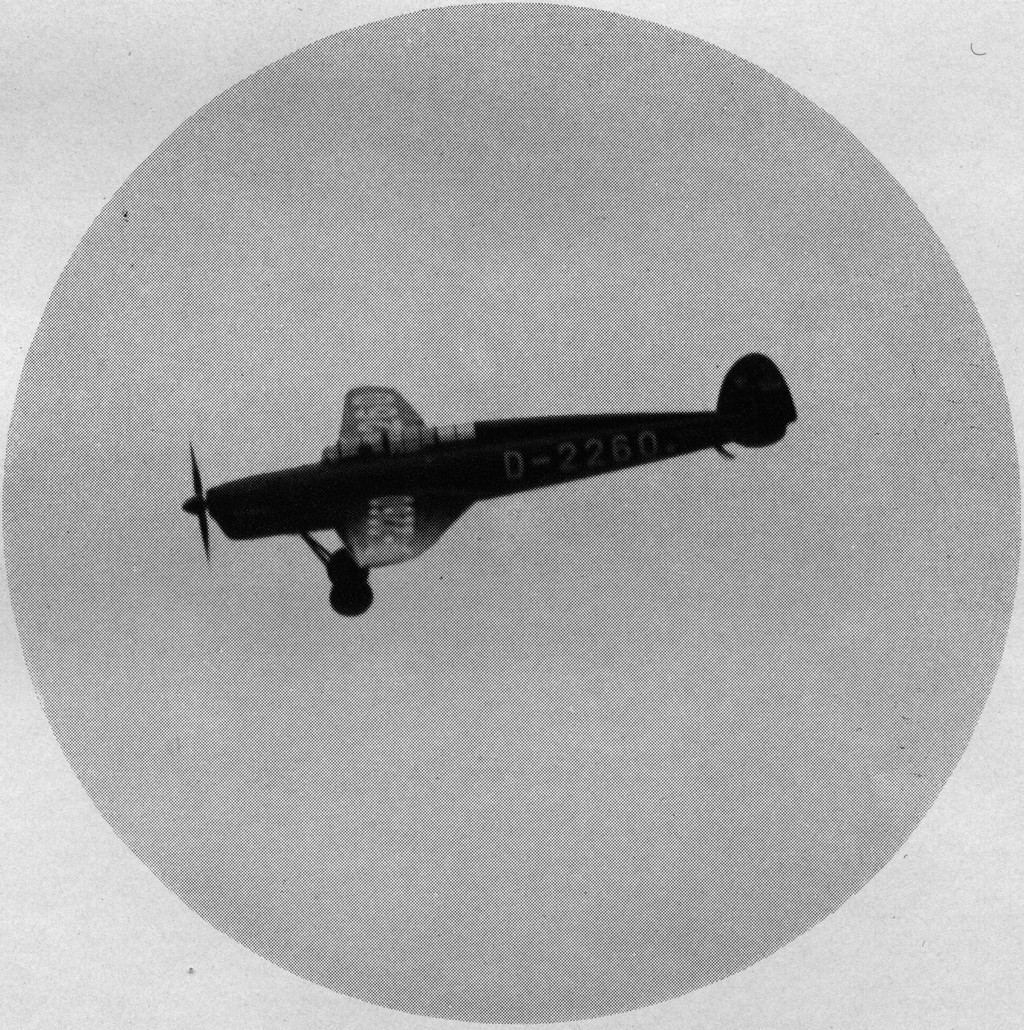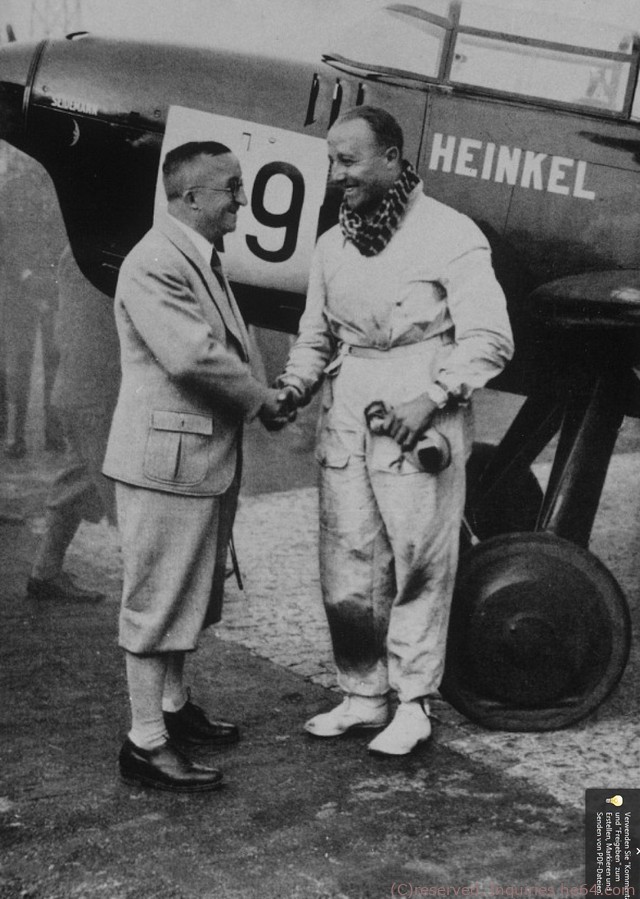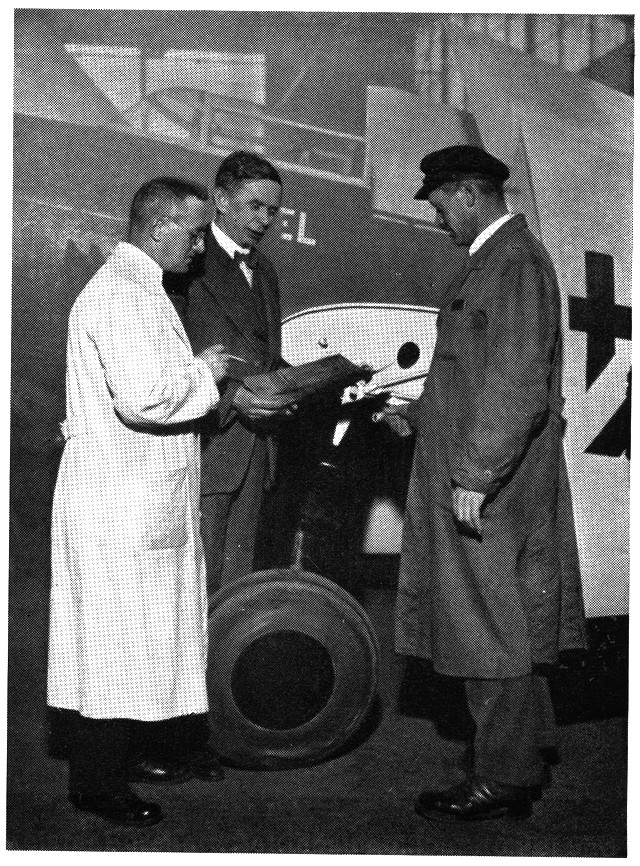Hans Seidemann in the anniversary script “fellowship of the air” on the occasion of the 50th birthday of Prof. Ernst Heinkel
It was in the year 1932, when the news hit the world of sport-aviation, that for the next international tourist plane contest also the Heinkel-factory would nominate aircraft.
Although the Heinkel-factory, forced by the then difficult circumstances, never took part in such an international contest, it showed soon at the trials, that the Heinkel-factory proceeded with full power.
After the decision to participate was made, it was Dr. Heinkel in persona, who together with his employees, Oberingenieur (chief-engineer) Schwärzler, the Günther-brothers, chief-pilot Junck amongst others pushed the completion of its competition-aircraft and cared personally, despite his manifold workload, in exemplary manner for his aircraft.
The success did then not fail to appear.
Designed indigeniously, provided with all that innovations of technology, made fit in weeklong trials, the aircraft could start in the fiercly faught contest.
As participant in the international tourist plane contest on the Heinkel “He 64” I take the liberty in the scope of this article and to the opportunity of the 50th anniversary of Dr. Heinkel, to chat out of my memory about those times.
End of April I had my first contact with the creator of this classy, shining red aircraft, which was then just completed. Already from the outside she was an aesthetic view. But also the performance of the aircraft with about 250 km per hour was improved so dramatically compared to the then known standard of performance, that we commonly awaited the contest quite comfortably.
Some weeks later we could start already lenghty, serious trials. The intoxcating hand of Dr. Heinkel was noticeable. Often he cared personally about the ‘state of things’, if necessary, also at night. Without rest and breaks the aircraft was tested in the most diverging directions. We worked continuously, on weekdays and sundays. One or the other of the old staff will remember those times with a light smile.
The work continued almost every night, since we flew at the day and there was always something to change or to improve.
Serene incidents outweighed fortunately by far the serious ones.
What furore it made then with the bathers at the beach of Warnemünde, when the “He 64” during the slow flight at a stiff westwind, thanks to its slotted wings, was almost standing still, as convincing as nowadays more modern aircraft. And then again, when the aircraft during calibrating flights shot past incredibly fast, given the circumstances then. A speed of almost 250 km/h was achieved with an Argus-engine of about 150HP.
And there was big anger with the bathing administration one Sunday very early in the morning, when, for an endurance-test, beginning at 5 A.M., the “He 64” in regular turns showed up every 10 minutes over the city and because of its noise disturbed the quietness.
The pacification assertions, that the fuel will soon be exhausted were belied, because with 140 liters of fuel there was noise generated over Warnemünde for 5 ¾ hours. Dr. Heinkel was smiling, the administration was furious!
I remember further, how the folding and unfolding of the wings was trained. To gain the maximum points in the contest, 2 persons had to achieve both in 1 Minute at most.
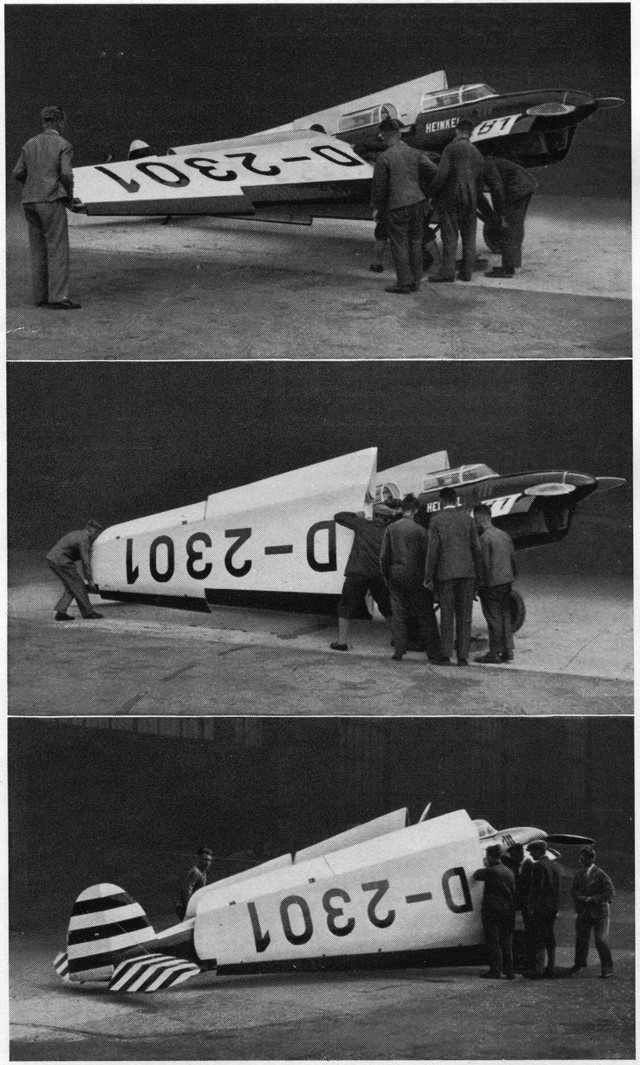
It did and did not work. All the time you had to hone here, it then clamped again there. All in all, it was not easy to be faster than a minute. There too, it was achieved by an initiative of Dr. Heinkel: He donated for that crew, which pushed the time below 1 minute, a basket with champaign and one bottle of wine for every second below 1 minute. And how it worked suddenly! The best crew scored 10 seconds, the next best 4 seconds shorter than a minute. Dr. Heinkel will not have regretted this somehow expensive fun. And we participants on the one hand enjoyed this really good performance and on the other side the wet appreciation. And when something broke, there was immediate remedy. No accuse put someone off the flight test, because Dr. Heinkel was too familiar with the stuff.
It was always critical at the short take-offs and landings, which lead over a 8m high rope into a marked landing field. Everytime the whole observing workforce went into the knees, when the aircraft landed like a ‘piano from the 4th floor’ into the marked target field and the strong stress almost bended the landing gear apart. Some of the engineers might have thaught: pilots must be rude people.
But it worked. And only this explained the good results, substantiated through these trials, in the contest later on. Systematically, it went on. All have been ensoled by this one thought, to assist for the case. If there have been difficulties, like they occur everytime everywhere, the only solution was: change, improve, continue!
If one thinks that this would have been american pushing, errs. Despite all the big demands Dr. Heinkel was always a help for his helpers when it came to support them.
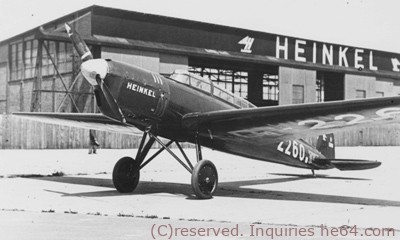
At the evening after the work, in his convival home at the beach of Warnemünde, at the tenpin-tournament in original outfit and the relating ‘stuff’, at the small bore shooting stand or wherever it was, again Dr. Heinkel was the soul of it all, and there was a lot of fun and josh. His aid for his followers, his life together with them, are the ground for his successes.
And so the contest approached, which was held in Staaken and from Staaken.
It had been Heinkel-aircraft, which were on the lead in all single examinations; be it the slow-flight, the fuel-consumption-test, the short take-off-trials over the 8m-barrier, the folding of the wings and what else of examinations there have been. Dr. Heinkel took it on to attend them all personally and to look after all.
The He 64 harvested a big triumph during the distance flight, which lead in 3 legs with 2500km each and under contact of numerous smaller landing strips from Berlin via Warschau-Prag-Vienna to Rome as first leg, from Rome via Florence-Nice-Lyon-Stuttgart-Bonn to Paris as second leg , from Paris via Amsterdam-Kopenhagen-Göteborg-Hamburg als third leg back to Berlin. Each leg could be covered at discretion in 2 days. The most chances have been given to the Italians, which impressed at the beginning of the first leg. They intended to be the first ones in their capital, Rome. But the “He 64” forged ahead from behind, where it was at the beginning and achieved the victory of the leg with great margin after a great race with the italian favorite Colombo. Big joy at the Germans! It showed now in the fierce contest, which qualities the ‘red devil’, which the aircraft was called soon, had.
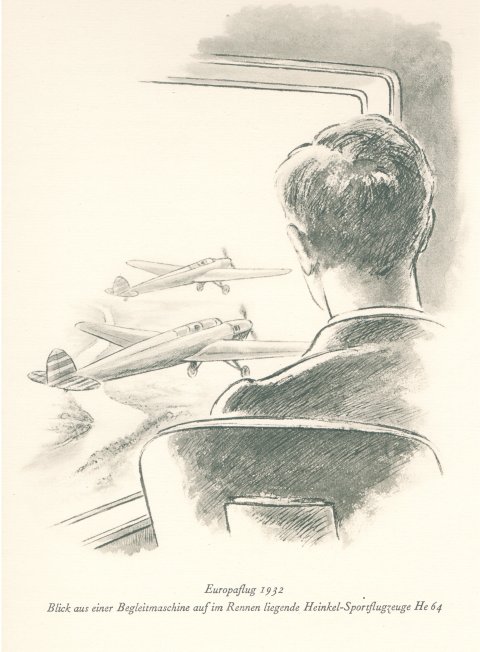
Also the second leg was flown in record-time. And after all: 2500km have been mastered on one day! That was an achievement by a small aircraft not seen until then. Unexpected for everyone was it done. The jury in Paris had already sent all members home, when suddenly – a few minutes before curfew- at almost complete darkness, a small red aircraft speeded over the finish-tape – the “He 64”!. This achievement was maybe the best, how the aircraft could thank its constructor.
Suddenly, the Heinkel-plane resounded throughout the land. The newspapers, not to speak from the flight magazines, have been full of praise. And this was deservedly, because the aircraft was a masterpiece! And as a prove of the just done, also the 3rd leg was achieved in one day.
So, this ‘Blitz-Flight’ was a great success, and the buzz which then on the evening roared against the Heinkel, was not least for the creator of this classy piece. To win 3 times the leg in such superior manner was the best prove for its flying qualities. And once again at the ‘Deutschlandflug 1933’ the Heinkel ‘He 64’ proved its superiority, when it completed the numerous day-legs in stunning speed and arrived every time as number one. And that it completed all these flights without accident and in any weather marvellously, issued their creators the best certificate.
That Dr. Heinkel later, obviously because of other grave reasons, did not take part again with his well-known and accepted aircraft in international contests, has been regretted very much by all sports-aviators. As the products of the Heinkel company in the sports aviation achieved an extraordinary reputation, the same was true earlier and later in the air transport and military aviation. Wherever they appeared, they attracted the biggest attention and dignified the factory of Dr. Heinkel through their quality. The small plant in Warnemünde became factories in the meantime. The crew assumed a shape, which is a multitude bigger than the number of the followers of Dr. Heinkel back then.
They pay tribute to themselves, if they are proud about what had been achieved then under difficult circumstances. All people, who then had been witnesses of this sportive act, will remember those followers. That is the origin of the pride and the performance of all, who work under the leadership of a man, whose life cannot be divided from the history and development of aviation. The 50th anniversary should not only be an opportunity to look back. Also the future of Dr. Heinkel and his factory lies under the most fortunate expectations. Our wishes for the future accompany Dr. Heinkel in the hope, that his proceedings furthermore succeed in order to produce the Great and Lasting for the german aviation.
